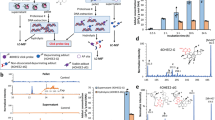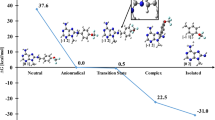Abstract
The analysis of damage products as biomarkers of inflammation has been hampered by a poor understanding of the chemical biology of inflammation, the lack of sensitive analytical methods and a focus on single chemicals as surrogates for inflammation. To overcome these problems, we developed a general and sensitive liquid chromatographic tandem mass spectrometry (LC/MS-MS) method to quantify, in a single DNA sample, the nucleoside forms of seven DNA lesions reflecting the range of chemistries associated with inflammation: 2′-deoxyuridine, 2′-deoxyxanthosine and 2′-deoxyinosine from nitrosative deamination; 8-oxo-2′-deoxyguanosine from oxidation; and 1,N2-etheno-2′-deoxyguanosine, 1,N6-etheno-2′-deoxyadenosine and 3,N4-etheno-2′-deoxycytidine arising from reaction of DNA with lipid peroxidation products. Using DNA purified from cells or tissues under conditions that minimize artifacts, individual nucleosides are purified by HPLC and quantified by isotope-dilution, electrospray ionization LC/MS-MS. The method can be applied to other DNA damage products and requires 4–6 d to complete depending upon the number of samples.
This is a preview of subscription content, access via your institution
Access options
Subscribe to this journal
Receive 12 print issues and online access
$259.00 per year
only $21.58 per issue
Buy this article
- Purchase on SpringerLink
- Instant access to full article PDF
Prices may be subject to local taxes which are calculated during checkout




Similar content being viewed by others
References
Coussens, L.M. & Werb, Z. Inflammation and cancer. Nature 420, 860–867 (2002).
Ohshima, H. & Bartsch, H. Chronic infections and inflammatory processes as cancer risk factors: possible role of nitric oxide in carcinogenesis. Mutat. Res. 305, 253–264 (1994).
Suerbaum, S. & Michetti, P. Helicobacter pylori infection. N. Engl. J. Med. 347, 1175–1186 (2002).
Dedon, P.C. & Tannenbaum, S.R. Reactive nitrogen species in the chemical biology of inflammation. Arch. Biochem. Biophys. 423, 12–22 (2004).
Halliwell, B. Effect of diet on cancer development: is oxidative DNA damage a biomarker? Free Radic. Biol. Med. 32, 968–974 (2002).
Shacter, E. & Weitzman, S.A. Chronic inflammation and cancer. Oncology 16, 217–226, 229 (2002).
Ohshima, H., Tatemichi, M. & Sawa, T. Chemical basis of inflammation-induced carcinogenesis. Arch. Biochem. Biophys. 417, 3–11 (2003).
Lewis, R.S., Tamir, S., Tannenbaum, S.R. & Deen, W.M. Kinetic analysis of the fate of nitric oxide synthesized by macrophages in vitro. J. Biol. Chem. 270, 29350–29355 (1995).
Dong, M., Wang, C., Deen, W.M. & Dedon, P.C. Absence of 2′-deoxyoxanosine and presence of abasic sites in DNA exposed to nitric oxide at controlled physiological concentrations. Chem. Res. Toxicol. 16, 1044–1055 (2003).
Cadet, J., Douki, T. & Ravanat, J.L. One-electron oxidation of DNA and inflammation processes. Nat. Chem. Biol. 2, 348–349 (2006).
Niles, J.C., Wishnok, J.S. & Tannenbaum, S.R. Peroxynitrite-induced oxidation and nitration products of guanine and 8-oxoguanine: structures and mechanisms of product formation. Nitric Oxide 14, 109–121 (2006).
Yu, H., Venkatarangan, L., Wishnok, J.S. & Tannenbaum, S.R. Quantitation of four guanine oxidation products from reaction of DNA with varying doses of peroxynitrite. Chem. Res. Toxicol. 18, 1849–1857 (2005).
Lee, S.H., Arora, J.A., Oe, T. & Blair, I.A. 4-Hydroperoxy-2-nonenal-induced formation of 1,N2-etheno-2′-deoxyguanosine adducts. Chem. Res. Toxicol. 18, 780–786 (2005).
Nair, J., Barbin, A., Velic, I. & Bartsch, H. Etheno DNA-base adducts from endogenous reactive species. Mutat. Res. 424, 59–69 (1999).
Dedon, P.C., Plastaras, J.P., Rouzer, C.A. & Marnett, L.J. Indirect mutagenesis by oxidative DNA damage: formation of the pyrimidopurinone adduct of deoxyguanosine by base propenal. Proc. Natl. Acad. Sci. USA 95, 11113–11116 (1998).
Zhou, X., Taghizadeh, K. & Dedon, P.C. Chemical and biological evidence for base propenals as the major source of the endogenous M1dG adduct in cellular DNA. J. Biol. Chem. 280, 25377–25382 (2005).
Marnett, L.J. Oxy radicals, lipid peroxidation and DNA damage. Toxicology 181–182, 219–222 (2002).
Karakaya, A., Jaruga, P., Bohr, V.A., Grollman, A.P. & Dizdaroglu, M. Kinetics of excision of purine lesions from DNA by Escherichia coli Fpg protein. Nucleic. Acids. Res. 25, 474–479 (1997).
Senturker, S. & Dizdaroglu, M. The effect of experimental conditions on the levels of oxidatively modified bases in DNA as measured by gas chromatography-mass spectrometry: how many modified bases are involved? Prepurification or not? Free Radic. Biol. Med. 27, 370–380 (1999).
Cooke, M.S., Olinski, R. & Evans, M.D. Does measurement of oxidative damage to DNA have clinical significance? Clin. Chim. Acta. 365, 30–49 (2006).
Dizdaroglu, M., Jaruga, P. & Rodriguez, H. Identification and quantification of 8,5′-cyclo-2′-deoxy-adenosine in DNA by liquid chromatography/mass spectrometry. Free Radic. Biol. Med. 30, 774–784 (2001).
Rodriguez, H. et al. Lymphoblasts of women with BRCA1 mutations are deficient in cellular repair of 8,5′-cyclopurine-2′-deoxynucleosides and 8-hydroxy-2′-deoxyguanosine. Biochemistry 46, 2488–2496 (2007).
Cadet, J. et al. Radiation-induced DNA damage: formation, measurement, and biochemical features. J. Environ. Pathol. Toxicol. Oncol. 23, 33–43 (2004).
Pouget, J.P. et al. Formation of modified DNA bases in cells exposed either to gamma radiation or to high-LET particles. Radiat. Res. 157, 589–595 (2002).
Dedon, P. et al. Challenges in developing DNA and RNA biomarkers of inflammation. Biomarkers Med. 1, 293–312 (2007).
Hu, C.W. et al. Comparison of analyses of urinary 8-hydroxy-2′-deoxyguanosine by isotope-dilution liquid chromatography with electrospray tandem mass spectrometry and by enzyme-linked immunosorbent assay. Rapid. Commun. Mass. Spectrom. 18, 505–510 (2004).
Randerath, K. & Randerath, E. 32P-postlabeling methods for DNA adduct detection: overview and critical evaluation. Drug Metab. Rev. 26, 67–85 (1994).
Dizdaroglu, M., Jaruga, P., Birincioglu, M. & Rodriguez, H. Free radical-induced damage to DNA: mechanisms and measurement. Free Radic. Biol. Med. 32, 1102–1115 (2002).
Cadet, J. et al. Facts and artifacts in the measurement of oxidative base damage to DNA. Free Radic. Res. 29, 541–550 (1998).
Dizdaroglu, M. Facts about the artifacts in the measurement of oxidative DNA base damage by gas chromatography-mass spectrometry. Free Radic. Res. 29, 551–563 (1998).
Cadet, J. Assesment of oxidative base damage to isolated and cellular DNA by HPLC-MS/MS measurement. Free Radic. Biol. Med. 33, 441–449 (2002).
Roberts, D.W., Churchwell, M.I., Beland, F.A., Fang, J.L. & Doerge, D.R. Quantitative analysis of etheno-2′-deoxycytidine DNA adducts using on-line immunoaffinity chromatography coupled with LC/ES-MS/MS detection. Anal. Chem. 73, 303–309 (2001).
Dong, M. & Dedon, P.C. Relatively small increases in the steady-state levels of nucleobase deamination products in DNA from human TK6 cells exposed to toxic levels of nitric oxide. Chem. Res. Toxicol. 19, 50–57 (2006).
ESCODD Comparative analysis of baseline 8-oxo-7,8-dihydroguanine in mammalian cell DNA, by different methods in different laboratories: an approach to consensus. Carcinogenesis 23, 2129–2133 (2002).
Pang, B. et al. Lipid peroxidation dominates the chemistry of DNA adduct formation in a mouse model of inflammation. Carcinogenesis 28, 1807–1813 (2007).
Nair, J. et al. Etheno adducts in spleen DNA of SJL mice stimulated to overproduce nitric oxide. Carcinogenesis 19, 2081–2084 (1998).
Cadet, J., Douki, T., Gasparutto, D. & Ravanat, J.L. Oxidative damage to DNA: formation, measurement and biochemical features. Mutat. Res. 531, 5–23 (2003).
Chen, B., Bohnert, T., Zhou, X. & Dedon, P.C. 5′-(2-Phosphoryl-1,4-dioxobutane) as a product of 5′-oxidation of deoxyribose in DNA: elimination as trans-1,4-dioxo-2-butene and approaches to analysis. Chem. Res. Toxicol. 17, 1406–1413 (2004).
Kusmierek, J.T. & Singer, B. 1,N2-ethenodeoxyguanosine: properties and formation in chloroacetaldehyde-treated polynucleotides and DNA. Chem. Res. Toxicol. 5, 634–638 (1992).
Zhang, W., Rieger, R., Iden, C. & Johnson, F. Synthesis of 3,N4-etheno, 3,N4-ethano, and 3-(2-hydroxyethyl) derivatives of 2′-deoxycytidine and their incorporation into oligomeric DNA. Chem. Res. Toxicol. 8, 148–156 (1995).
Doerge, D.R., Churchwell, M.I., Fang, J.L. & Beland, F.A. Quantification of etheno-DNA adducts using liquid chromatography, on-line sample processing, and electrospray tandem mass spectrometry. Chem. Res. Toxicol. 13, 1259–1264 (2000).
Hillestrom, P.R., Weimann, A. & Poulsen, H.E. Quantification of urinary etheno-DNA adducts by column-switching LC/APCI-MS/MS. J. Am. Soc. Mass. Spectrom. 17, 605–610 (2006).
Green, T. & Hathway, D.E. Interactions of vinyl chloride with rat-liver DNA in vivo. Chem. Biol. Interact. 22, 211–224 (1978).
Singh, R., McEwan, M., Lamb, J.H., Santella, R.M. & Farmer, P.B. An improved liquid chromatography/tandem mass spectrometry method for the determination of 8-oxo-7,8-dihydro-2′-deoxyguanosine in DNA samples using immunoaffinity column purification. Rapid. Commum. Mass. Spectrom. 17, 126–134 (2003).
Suzuki, T., Yamaoka, R., Nishi, M., Ide, H. & Makino, K. Isolation and characterization of a novel product, 2′-deoxyoxanosine, from 2′-deoxyguanosine, oligodeoxynucleotide, and calf thymus DNA treated with nitrous acid and nitric oxide. J. Am. Chem. Soc. 118, 2515–2516 (1996).
Stimson, M.M. & Reuter, M.A. Ultraviolet absorption spectra of nitrogenous heterocycles. VII. The effect of hydroxy substitution on the ultraviolet absorption of the series: hypoxanthine, xanthine and uric acid. J. Am. Chem. Soc. 65, 153–155 (1943).
Acknowledgements
We gratefully acknowledge financial support for this work from the National Institutes of Health (ES002109, CA116318, CA26735, ES59790, CA103146, CA110261, S10RR023783).
Author information
Authors and Affiliations
Corresponding author
Rights and permissions
About this article
Cite this article
Taghizadeh, K., McFaline, J., Pang, B. et al. Quantification of DNA damage products resulting from deamination, oxidation and reaction with products of lipid peroxidation by liquid chromatography isotope dilution tandem mass spectrometry. Nat Protoc 3, 1287–1298 (2008). https://doi.org/10.1038/nprot.2008.119
Published:
Issue date:
DOI: https://doi.org/10.1038/nprot.2008.119
This article is cited by
-
Isotope-dilution mass spectrometry for exact quantification of noncanonical DNA nucleosides
Nature Protocols (2019)
-
Mapping and elucidating the function of modified bases in DNA
Nature Reviews Chemistry (2017)
-
Association between Oxidative DNA Damage and Risk of Colorectal Cancer: Sensitive Determination of Urinary 8-Hydroxy-2′-deoxyguanosine by UPLC-MS/MS Analysis
Scientific Reports (2016)
-
Determination of DNA adducts by combining acid-catalyzed hydrolysis and chromatographic analysis of the carcinogen-modified nucleobases
Analytical and Bioanalytical Chemistry (2016)
-
Mitochondrial DNA maintenance: an appraisal
Molecular and Cellular Biochemistry (2015)



